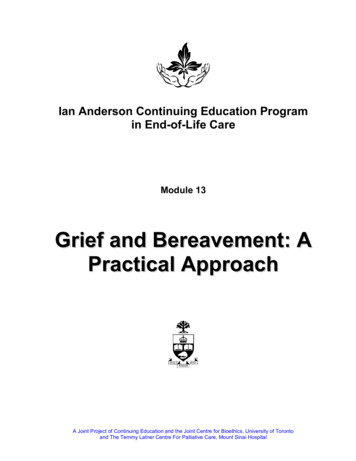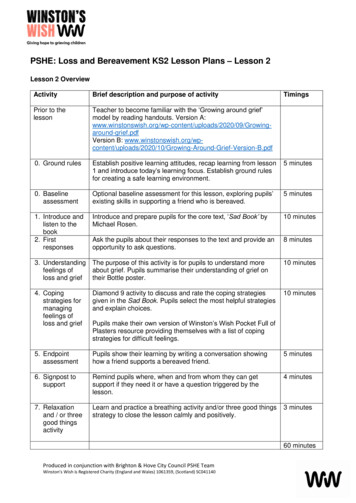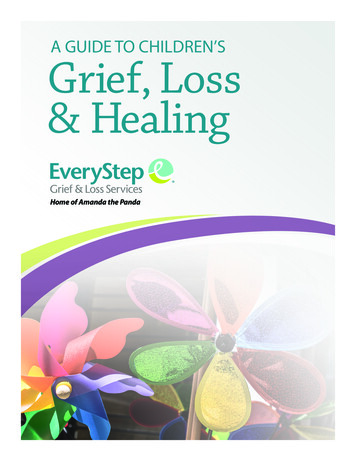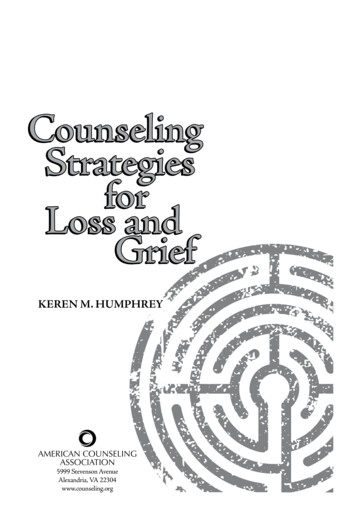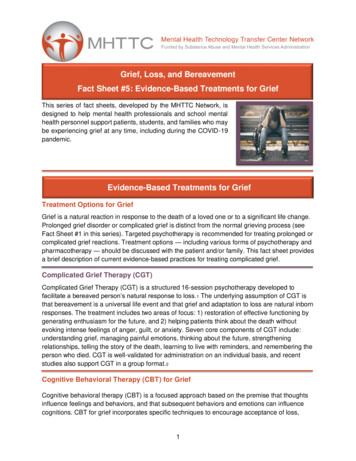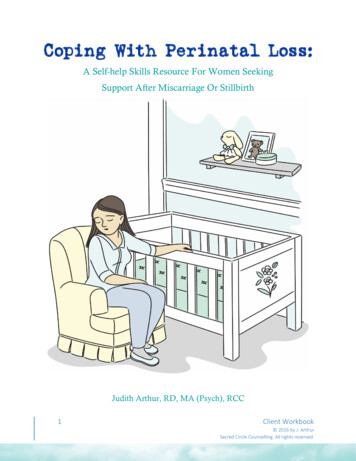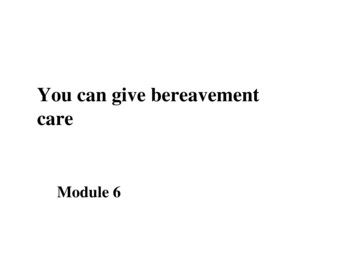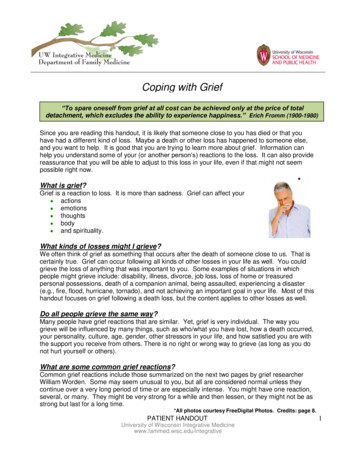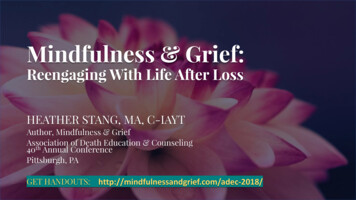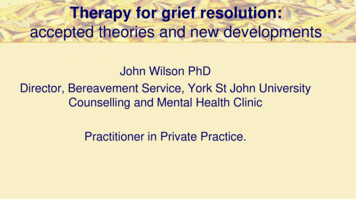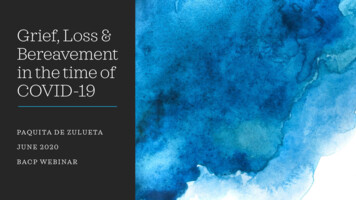
Transcription
Grief, Loss &Bereavementin the time ofCOVID-19PAQ U I TA D E Z U L U ETAJUNE 2020B AC P W E B I NA R
GRIEF“No one told me that grief felt so like fear. I am not afraid, but the sensationis like being afraid. The same fluttering in the stomach, the samerestlessness, the yawning. I keep on swallowing.At other times it feels like being mildly drunk, or concussed. There is a sortof invisible blanket between the world and me. I find it hard to take in whatanyone says.”C.S Lewis A Grief Observed.
GRIEF“Grief is different. Grief has no distance. Grief comes in waves, paroxysms,sudden apprehensions that weaken the knees and blind the eyes andobliterate the dailiness of life. Virtually everyone who has ever experiencedgrief mentions this phenomenon of ’waves’.”Joan Didion. The Year of Magical Thinking.
Normal or Uncomplicated GriefDerived from old French grever – to burden, afflict, oppress. Latin - Gravis– weighty, heavy.Loss and grief are a fundamental part of human life.The great majority of bereaved do not need help other than from family &friends.It is a universal human response to the disruption of an affectional bond i.ethe loss of a loved one. “Grief is the form love takes when someone we lovedies” (Shear 2016).
Bowlby’s work describes how we form attachment‘working models’ – a neurobiological affectivecognitive system that relates to our sense of self andhow we self-regulate.Grief - adisruptedattachmentDeath of a loved one disrupts our ‘assumptiveworld’ (Colin Murray Parkes) and we have to createa new one. 4 attachment styles (Mary Ainsworth):Secure –autonomousAvoidant dismissiveAnxious –preoccupiedDisorganised– unresolved
Myth busting Grief does not evolve in stages (Kubler-Ross). This stage model does not addressthe full physical, psychological, social, cultural and spiritual aspects of bereavement.Nor is grieving a linear process (see below). There is now a shift away from the necessity of ‘letting go’ of the deceased towards arecognition of the potential for a healthy role of maintaining bonds with thedeceased. Research evidence fails to support idea that grieving is necessarily associated withdepression, anxiety, PTSD or that a complex process of grief work is critical to recovery.Indeed there is the possibility of ‘post-traumatic growth’ following loss.
From stages toOscillationDual processing modelof Stroebe and Schut(1999)
1. To accept the reality of the loss2. To process the pain of griefWorden’sTasks ofMourning3. To adjust to a world without thedeceaseda) External adjustments – daily livingb) Internal adjustments – who am Inow?c) Spiritual adjustments – findingmeaning, new assumptive world4. To find enduring connection with thedeceased while embarking on a new life.
Meaning reconstructionThe attempt to find or create new meaning and purpose in life as a survivor, as well as inthe death of the loved one. The need to recreate a self narrative and identity.The construction of meaning as interpersonal as well as personal, anchored in culturalas well as intimate contexts. (Neimeyer 2000). [Social constructionism]Meaning-making has 2 concepts and two distinct processes:1. Making sense of the loss2. Finding benefits from the loss (Davis, Nolen-Hoeksema, Larson 1998)But some individuals do not search for meaning and adjust well to loss.
Complicated or Complex GriefComplicated grief (CG) – also called Prolonged Grief Disorder (PGD) ,Complex grief or Traumatic Grief (less used now). Intense/chronic grief.Around 10-15% of bereaved people experience CG.People with CG suffer prolonged acute grief symptoms, and struggleunsuccessfully to rebuild a meaningful life without the deceased person.People with CG get stuck with loss-related and restoration-focusedprocesses. Significant impairment in social, occupational and other functions.A candidate for DSMV? (Shear et al. 2011)
Symptoms of CG –NB: Must still be present after 6 months Intense yearning or longing. Cannot accept person has died. Preoccupying memories, thoughts or images of the deceased person thatmay be intrusive and interfere with engaging in meaningful activities orrelationships. Rumination. Compulsively seeking proximity. Recurrent painful, hard-to-control emotions such as guilt, anger, bitterness. Avoidance of situations or people that threaten to trigger memories. Difficulties in restoring a sense of purpose or joy in life.
Antecedents: Depression/anxiety disorders, earlyinsecure attachment, multiple trauma or loss.Relationship based – Nature of the relationship, whodied.Risk factors forCGDeath circumstances – sudden, traumatic, multiple,preventable, ambiguous, stigmatized (suicide).Personality – coping style, attachment style,age/gender, self efficacy/esteem, ‘assumptive world’.Social support, roles, religious resources, culturalexpectations,Other concomitant stressors
Will COVID19 increase risk for CG?Many Covid-19 deaths are traumatic – with little warning and often ininhumane circumstances. Relatives often unable to see their loved onesbefore/after death and if they can, they may be unable to be close to themor to hold them.The sheer numbers of deaths leading to mass disposal of bodies or evenmass burials – profoundly depersonalising. The person becomes a statistic.The social support, religious rituals and cultural practices severely curtailedsuch that people are deprived of the solace and support they wouldnormally receive.
Good therapy“Good psychotherapy must be focused on helping peopleconfront their loss, regain confidence in themselves, their livesand their future and undertake activities that are fulfilling andgive meaning”Paul Boelen 2016
Working out which of the 4 tasks they strugglewith and work with those. Grief monitoring diary. Letter writing. Journaling.Integratedtherapy for CG– NB ‘no sizefits all’ Positive and negative memories. Dreaminterpretation. Working with ‘Linking objects’. Imaginal revisiting – can include positive copingimagery/rescripting /EMDR. Personal goals work. Restoring self esteem. Selfcompassion. Restoring relationships. Gestalt techniques – facilitated conversation withdeceased. Empty chair/photos.
The compassionate response to suffering“Compassion is a sensitivity to suffering in self and others with acommitment to try to alleviate and prevent it. The courage to becompassionate lies in the willingness to see into the nature andcauses of suffering - be that in ourselves, in others and thehuman condition.”https://www.compassionatemind.co.uk/
CompassionPerception, Emotion, Cognition & Action Awareness of, & resonance with the suffering of the other(emotional empathy). Imagination & perspective taking – what illness means for thisparticular person (cognitive empathy). Distress tolerance (can manage ‘emotional contagion’ and notbe overwhelmed) – resilience. Motivation to relieve the suffering of another leading tocompassionate action.
THE SCIENCEOFCOMPASSION:Three EmotionSystems[Paul Gilbert]PAUL GILBERT. THE COMPASSIONATE MIND 2009
Fear, competition , overload andstress activate the Threat Systemshutting down the affiliative system.People hunker down for survival.They are ‘tuned out’.Imbalance ofthe SystemsIn a high stress, high threatenvironment, there may be increasedaggression, reduced compassion,reduced ability to self-soothe, andreduced resourcefulness andcreative problem solving.
Compassionfocusedtherapy:Key elementsof CFTDeveloping the compassion system & selfsoothing with specific exercises such ascompassionate meditation, compassionate imagery,compassionate self-talk etc.Damping down self attacking, self –criticism –particularly relevant if there is strong guilt and/orshame.Mindfulness training – non-judgmentalawareness.Self compassion training - developing:1)Mindfulness of one’s own suffering, 2) selfkindness and 3) awareness of our commonhumanity (Kristin Neff) https://self-compassion.org/
CONCLUSION Grief is a normal yet painful process that integral to the human condition. It is distinct from depression, anxiety or PTSD although it may share someof the symptomatology. Complicated (complex) grief does seem to be a distinct, disabling conditionwhich benefits from tailored therapy. As therapists we should not intervene too soon but be aware of those whoare most at risk of CG & offer therapeutic support when appropriate.
Selected References - articlesBoelen PA. Improving the understanding and treatment of complex grief: an important issuein psychotraumatology. European J Psychotraumatology 2016; 7:32609.Glass RM. Is grief a disease? Sometimes. JAMA 2005;293:2658-2660Hall C. Bereavement Theory: recent developments in our understanding of grief andbereavement. 2014. Cruse Bereavement Care.Neimeyer RA. Searching for the meaning of meaning: grief therapy and the process ofreconstruction. Death Studies 2000; 541:541-558.Prigerson HG, Jacobs SC. Caring for bereaved patients. JAMA 2001. 286:1369-76.Stroebe M & Schut H. The dual process model of coping with bereavement: rationale anddescription. Death Studies 1999; 23:197-224Shear MK. Complicated grief treatment. 2010; Cruse Bereavement Care.
Selected BibliographyJoan Didion. The year of magical thinking. Fourth Estate 2005.C.S. Lewis. A grief observed 1966.Colin Murray Parkes. Holly Prigerson. Studies of grief in adult life. 4th Edn. 2010Colin Neimeyer (ed) Techniques or grief therapy. Routledge. 2015.Julia Samuels. Grief works. Penguin. 2018.Worden WJ. Grief counselling and therapy. A handbook for the mental health practitioner.Routledge 5th edn 2018Gilbert P. Compassion focused therapy – distinctive features. Routledge 2010.
Thank you.p.dezulueta@imperial.ac.uk@PdeZ doc
Worden WJ. Grief counselling and therapy. A handbook for the mental health practitioner. Routledge 5. th. edn 2018 Gilbert P. Compassion focused therapy – distinctive features. Routledge 2010. Thank you. p.dezulueta@imperial.ac.uk @PdeZ_doc . Title: Grief, Loss
